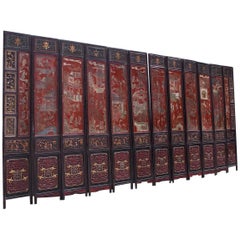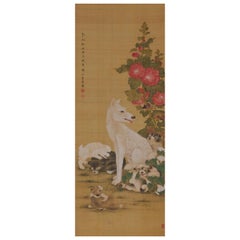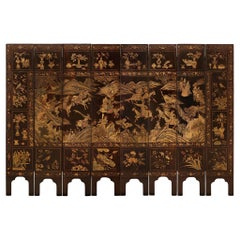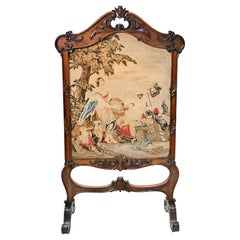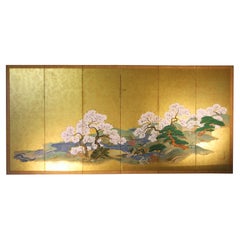1840s Paintings and Screens
to
1
2
172
682
911
150
314
195
107
38
4
33
14
12
25
29
28
26
8
1
1
1
1
1
2
2
1
1
2
2
2
Period: 1840s
Chinese Coromandel Red Lacquer 12-Panel Figural and Landscape Screen. Circa 1840
Located in Charleston, SC
Chinese Coromandel figural red lacquer 12-panel screen depicting pagoda and landscape scenes, decorative gilt floral border panels, gilt carved lower panels, and reverse side depicti...
Category
Chinese Chinese Export Antique 1840s Paintings and Screens
Materials
Wood, Giltwood, Lacquer, Paint
1844 - Chichi, Japanese Scroll Painting. Colour on Silk
Located in Kyoto, JP
Mother’s Breast (Chichi) 1844
Hanging scroll. Ink, pigments and gofun on silk.
Inscription:
Kouka era, dragon year, late winter, painted by Shozan Yashou
Artist’ seals:
...
Category
Japanese Edo Antique 1840s Paintings and Screens
Materials
Silk
Related Items
Chinese Patriarch and Matriarch Ancestral Scroll Painting
Located in Rio Vista, CA
Magnificent Chinese scroll ancestor painting showing patriarch and matriarch of a high ranking status civil official. This unusual scroll depicts the dignitary couple seated below a ...
Category
Chinese Qing 1840s Paintings and Screens
Materials
Paper, Wood, Paint
$2,640 Sale Price
44% Off
H 76 in W 48 in D 1 in
A spectacular Chinese 18th century Coromandel Lacquered 8-panel floor screen
Located in West Palm Beach, FL
A spectacular and most impressive Chinese 18th century Coromandel Lacquered screen. Each of the eight panels are raised by two feet formed from an urn shaped arch below a foliate decorated band. The center of each panel joins together to depict various scenes executed in the Kuan Cai or "incised colors" technique. The front side of the screen features bottom panels showing various birds on/near a variety of blooming trees, while the central panel depicts a battle scene on horseback through hills and forests. The tops show a variety of vases holding floral branches, and bowls of fruit mirroring...
Category
Chinese Chinese Export Antique 1840s Paintings and Screens
Materials
Wood
$68,900
H 84.5 in W 123 in D 1 in
Tall Eight Panel Lacquered Coromandel Chinese Screen
Located in Locust Valley, NY
A tall, eight panel lacquered coromandel Chinese screen. Crafted of enamel and black lacquer, decorated with figures in a court setting. Reverse side depicts flowering plants. Panel...
Category
1840s Paintings and Screens
Materials
Enamel
Japanese Two-Panel Screen: Ink Landscape on Silk
By Shunyu
Located in Hudson, NY
Japanese Two Panel Screen: Ink Landscape on Silk, Meiji period (1868 - 1912) painting of a man riding a mule on a pathway through the Kurotani mountains with a thatched roof shelter ...
Category
Japanese Meiji Antique 1840s Paintings and Screens
Materials
Silk, Wood
Japanese Two Panel Screen Mountain Landscape on Gold Silk
Located in Hudson, NY
Nanga School; by female artist Kia Kozan. Showa Period (1926-1989) Translation: Kai Kozan 1867-1961, from Bungo area in Kyushu. Graduated from Bunchu-en Girls School. Signature and s...
Category
Japanese 1840s Paintings and Screens
Materials
Paper
Chinese Export Lacquered Six Panel Coromandel Landscape Screen
Located in Rio Vista, CA
Beautifully weathered patina Chinese export lacquered coromandel screen with six double sided panels. The screen features a mountain landscape on one si...
Category
Chinese Chinese Export 1840s Paintings and Screens
Materials
Brass
Japanese Six Panel Screen, Peonies and Young Growth on Gold Silk
Located in Hudson, NY
Rimpa floral scene. Pigment on gilded silk, signature and seal read: Hattori Shunyo. Bold colors and strong design elements combined with the trademark tarashikomi (diluted elements created when water is applied to the surface before or after pigments causing them to diffuse) exhibit the artists deep devotion to this important Japanese painting tradition. Notes about artist: Hattori Shunyo (b. 1883) was an artist from Kyoto who graduated the (now) Kyoto Municipal University of Art and fell under the circle of Yamamoto Shunkyo...
Category
Japanese 1840s Paintings and Screens
Materials
Brocade, Silk
$21,275
H 37.25 in W 109 in D 0.75 in
Vintage Chinese Eight Panel Coromandel Screen
Located in Houston, TX
Vintage Chinese eight panel coromandel screen composed of wood and lacquer. This screen depicts daily life on one side and a landscape with birds and fauna on the other side.
Category
Chinese Chinese Export 1840s Paintings and Screens
Materials
Wood, Lacquer
Vintage Four Panel Lacquer and Carved Hardstone Screen
Located in Vancouver, British Columbia
An early 20th century Asian black lacquer screen with carved coloured hardstone figures and scenery.
Category
French Chinoiserie Vintage 1840s Paintings and Screens
Materials
Stone
$3,960 Sale Price
20% Off
H 48 in W 48 in D 1 in
Chinese Export Four Panel Coromandel Screen Pearlescent Landscape
Located in Rio Vista, CA
Captivating Chinese export four-panel coromandel screen featuring an idyllic seascape with beauties. The background is comprised of pearlescent crystal sand that shines like glitter ...
Category
Chinese Chinese Export 1840s Paintings and Screens
Materials
Brass
$3,040 Sale Price
20% Off
H 72 in W 64 in D 1 in
Chinese Six-Panel Carved Hardstone Lacquered Coromandel Screen
Located in Rio Vista, CA
Magnificent Chinese export six panel folding coromandel screen featuring hand-carved soapstone and hardstone decoration. The lacquered panels have recessed windows showcasing hand-ca...
Category
Chinese Chinese Export 1840s Paintings and Screens
Materials
Soapstone, Brass
Chinese Export Six Panel Coromandel Screen Gilt Courtyard
Located in Rio Vista, CA
Exceptional 20th century Chinese export six panel coromandel screen featuring a busy idyllic courtyard scene with a dramatic gilt background. The screen has six panels lacquered and ...
Category
Chinese Chinese Export 1840s Paintings and Screens
Materials
Brass
Previously Available Items
Victorian Tapestry Screen Needlepoint Hand Woven 1840 Pastoral
Located in Potters Bar, GB
Wonderful Victorian tapestry screen showing a delightful English pastoral scene
We date this to circa 1840 and it comes in the mahogany frame which ...
Category
Victorian Antique 1840s Paintings and Screens
Materials
Mahogany
19th Century Japanese Landscape Rinpa School Folding Screen Six Panels Gold Left
Located in Brescia, IT
Landscape with flowering sakura trees of the Edo period.
Six-panel screen painted with mineral pigments and inks on gold leaf from the Rinpa School.
Category
Japanese Edo Antique 1840s Paintings and Screens
Materials
Gold Leaf
H 67.33 in W 149.61 in D 0.79 in
Two Panel Ink and Gold Leaf Japanese Screen
Located in Stamford, CT
Two panel ink and gold leaf Japanese screen depicting water, weeping willows and a blossoming bush. 19th century Edo period in the style of the earlier 17th century Edo period.
Category
Japanese Edo Antique 1840s Paintings and Screens
Materials
Paper
Kishi Ganryo “Flowers of the Four Seasons” Japanese Folding Screen
By Kishi Ganryo
Located in Kyoto, JP
Kishi Ganryo (1798-1852)
“Flowers of the Four Seasons”
Six-panel screen, ink, color and gold leaf on paper.
Inscription: Utanosuke Ganryo
Artist seals:
Ganryo no in
Shiryo
Dimensions:
170 cm x 556 cm (67” x 219”)
Flowers and plants have long held an important role as signifiers of meaning in Japanese culture. Hanakotoba is the Japanese ‘language of flowers’. Essentially, each flower has its own meaning, often based on its physical attributes and/or well known appearances in historical art and literature. This floral screen by Kishi Ganryo is rich with emotional sentiments. The flowers chosen epitomise femininity and the theme is unambiguously romantic. The work was likely commissioned as a dowry gift for a bride.
The screen is ‘read’ from right to left, from spring through to winter. Flowers associated with spring include wisteria, which represents the intoxication of love, bleeding hearts embody femininity and gentleness, and the stem peony timidity and purity. Moving through to summer the pink morning glories represent binding love; they are entwined around tiger lilies which embody prosperity. The white chrysanthemum, an eternal symbol of autumn, represents trust and purity. It is placed next to the cockscomb which stands for emotion and affection. Amongst the pampass grass is the bellflower, which represents unchanging love and honesty. In winter the Nandina flourishes and it is seen as a purifying plant. It is set among bamboo which is a symbol of perseverance and tolerance.
It is highly unusual in that the four seasons are represented on one screen as a complete work of art. Almost invariably spring and summer would be presented on one screen and fall and winter on the matching pair. The screen is also extraordinary in its grand size, measuring 18 feet across. There is a wonderful Japanese sense of composition, revealing just the centre part of the tree-trunk, and the tips of plants and grasses, which gives the impression that you are looking out of a window. In particular the twisting wisteria vines bring to mind Maruyama Okyo’s famous wisteria screens. Against the gold-leaf ground the flowers dazzle with realism. It is a very important and representative work by Ganryo, who was known as a careful observer of nature and talented colorist.
Kishi Ganryo’s given name was Hamatani Masatoshi. He studied painting under Kishi Ganku...
Category
Japanese Edo Antique 1840s Paintings and Screens
Materials
Gold Leaf
Recently Viewed
View AllMore Ways To Browse
Lattice Panel Wood
Hanging Japanese Screen
Japanese Lattice
Japanese 19th Century Meiji Period Silk Painting
Japanese Buddhist Screen
Japanese Carved Screen
Japanese Screens And Doors
Japanese Autumn Screen
Japanese Screens Six Fold
Japanese Wood Room Divider
Kyoto Silk Painting
Japanese Dragon Painting
Japanese Birds Painted On Silk
Heian Period
Japanese Crane Panel
Japanese Divider Screen
Japanese Pheasant
Japanese Screen Chrysanthemums
